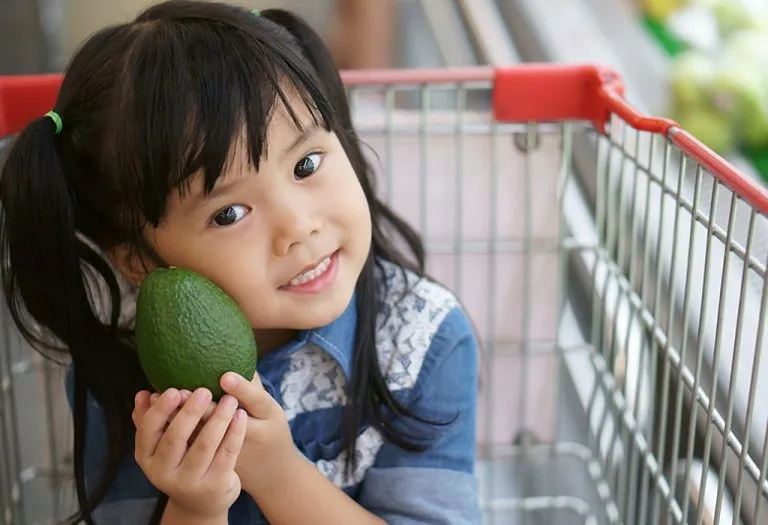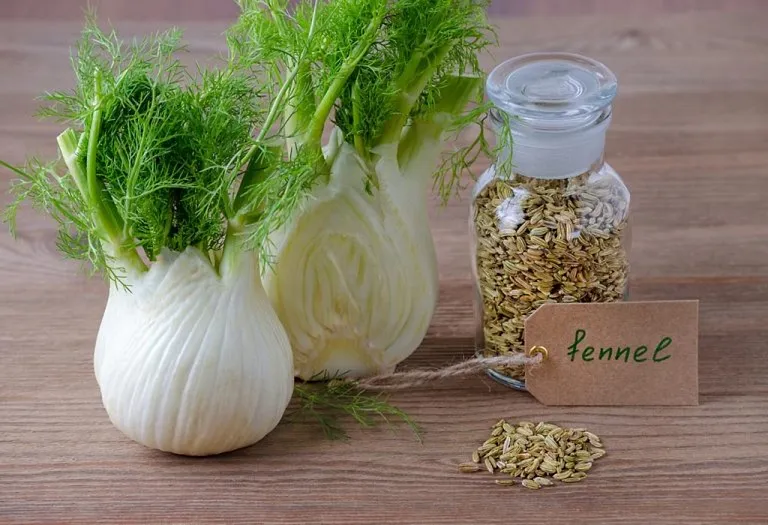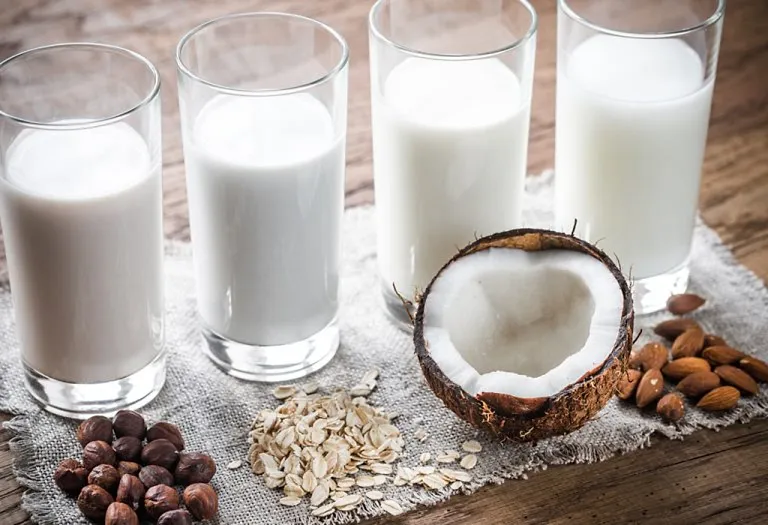Introducing Avocado to Babies: When, Why & How

- What Is Avocado Fruit?
- Nutritional Value of Avocado
- Is Avocado Good for Infants?
- When Can You Introduce Avocado to Your Baby?
- Health Benefits of Avocado for Infants
- How to Feed Avocado to Your Baby?
- How to Cut Avocado for Baby-Led Weaning?
- Tips for Feeding Avocado to Your Baby
- Quick and Short Avocado Recipes for Babies and Toddlers
- FAQs
It is challenging for mothers when their child transitions to solid foods. Whether you are a first-time or a second-time mother, it is always a new experience when your little one begins his first trials with solids. As parents, we always want to give our babies the best. Hence, it is essential to select foods that provide wholesome nutrition and appeal to their taste buds. Experts advise introducing a variety of fruits and vegetables to a baby’s diet, one at a time, for them to accept the taste. One such wonder we will discuss is the introduction of avocado for babies. Avocado for baby introduces a rich source of essential nutrients, fostering healthy growth and development in their formative years. But knowing when and how to give avocados to your baby is necessary. So, when can babies eat avocado? Read on to learn more.
What Is Avocado Fruit?
Avocado is a convenient choice for your baby’s diet. It’s readily available in supermarkets and is easy to prepare. Resembling a large berry with a pulpy mass on the inside, it boasts a creamy texture and rich taste that babies often love. Avocados typically ripen after being plucked; you can quickly identify the best ones through their colour and texture. A ripe avocado is supple and soft, making it easy to mash into a perfect pulp for your little one to enjoy.
Many nutrients in avocado make it a wholesome wonder food. It has good monounsaturated fats (5) and is dense in vitamins and antioxidants. Hence, it is considered a healthy food option for children and adults. Let’s take a look at its nutritional value.
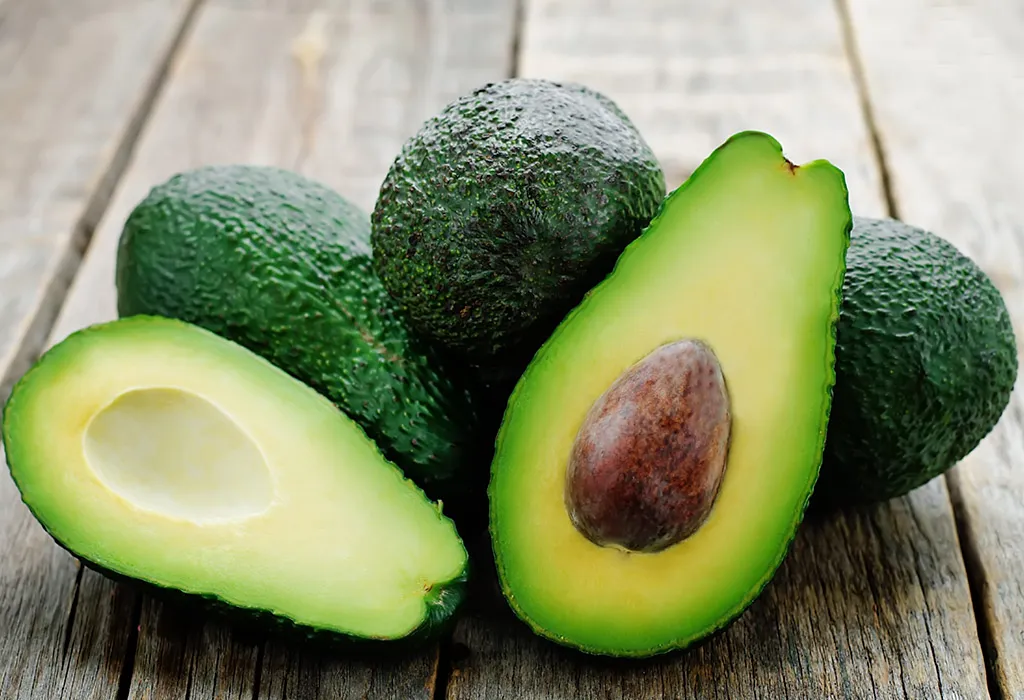
Nutritional Value of Avocado
The fruit is not only tasty because of its rich, creamy texture but is also healthy because it is nutrient-dense. The following nutrition information is for every 100 g of avocados (1).
| Nutrient | Unit Value per 100 g |
| Energy | 160 kcal |
| Carbohydrates | 8.53 g |
| Natural sugars | 0.66 g |
| Fiber | 6.7 g |
| Protein | 2 g |
| Iron | 0.55 mg |
| Fat | 14.66 g |
| Potassium | 485 mg |
| Calcium | 12 mg |
| Magnesium | 29 mg |
| Copper | 0.19 mg |
| Fluoride | 7 µg |
| Zinc | 0.64 mg |
| Phosphorus | 52 mg |
| Sodium | 23 mg |
| Choline | 14.2 mg |
| Selenium | 0.4 µg |
| Manganese | 0.142 mg |
| Vitamin C | 10 mg |
| Vitamin B6 | 0.257 mg |
| Vitamin A | 7 µg |
| Vitamin K | 21 µg |
| Vitamin E | 2.07 mg |
| Vitamin B9 | 81 µg |
| Vitamin B1 (Thiamin) | 0.067 mg |
| Vitamin B2 (Riboflavin) | 0.13 mg |
| Vitamin B3 (Niacin) | 1.738 mg |
| Vitamin B5 (Pantothenic acid) | 1.389 mg |
Is Avocado Good for Infants?
As adults, we are well aware of avocados’ health and nutritional benefits, so they often find their way into our daily diets. However, when your baby reaches out to taste this fruit, you may wonder if babies can eat it. The answer is yes! The fruit provides a healthy dose of nutrients (mentioned above) and is good for infants and growing children.
There has been some confusion regarding the safety of avocados for very young children, though, considering they are fatty foods. Although avocados are high in fats, these are all healthy fats which are essential for growing kids.
Also, this fruit’s taste and texture make it an excellent choice for a balanced, healthy diet for infants as young as 4-6 months. This fruit can easily be mashed and served alone or with other foods. The taste is not overpowering; it adapts to different flavours easily and appeases young taste buds.
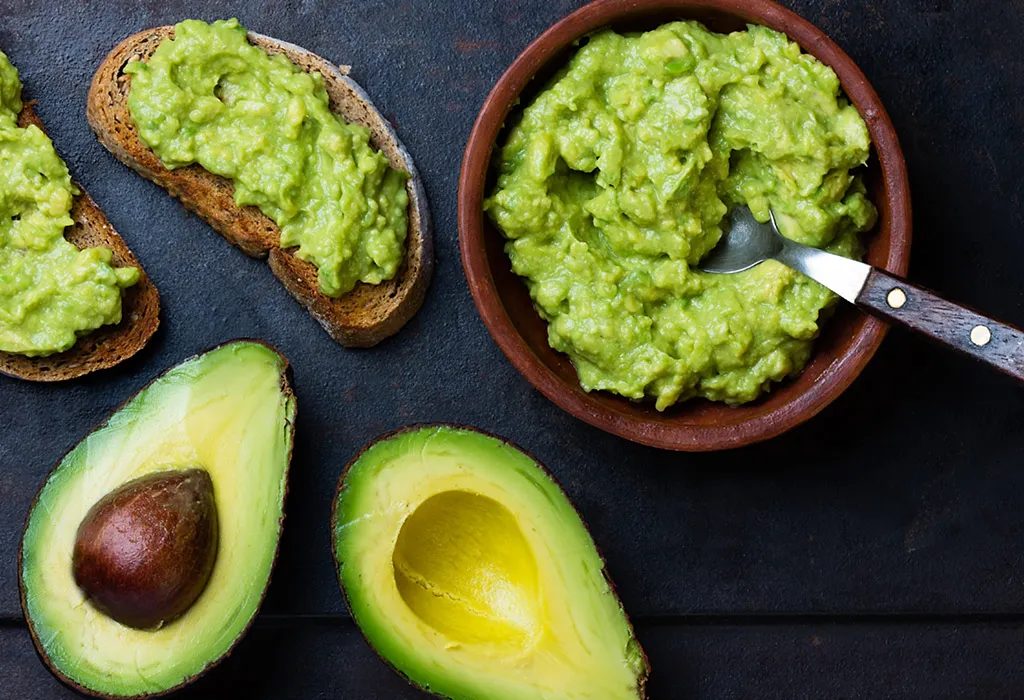
When Can You Introduce Avocado to Your Baby?
Infants undergo a lot of physical and mental growth in the first year of their life. Avocados can be introduced as one of the first foods for your baby as their nutritional value contributes to the development of the brain, too. Hence, you can introduce the fruit as early as your child is six months old and make it a regular diet component (3). Begin with avocado puree, which can be bought from a supermarket’s baby food section or made at home. Homemade avocado baby food is better as it is fresh and healthier. Your baby will gain health benefits, which we shall discuss now.
Health Benefits of Avocado for Infants
Avocado has the following health benefits for infants.
- Of the different health benefits of avocados, the most important one is that they contain a large number of fats that aid mental and physical growth in babies. Growing children need fat for their brains to develop properly, and avocados offer healthy fats that can fulfil this need. The mono-unsaturated fats in avocados are good fats that are very beneficial for a child’s overall development.
- Apart from containing good quantities of minerals like phosphorus, potassium, magnesium, calcium, sodium, and iron, it also contains small amounts of selenium, manganese, copper, and zinc, essential for overall development. This fruit also abundantly contains different vitamins, including vitamins B1, B2, Niacin, Folate, B6, and pantothenic acid, which facilitate the proactive development of the baby. It also has vitamins C and E that boost immunity and improve skin.
- The nutrients aid in developing the central nervous system and ensure normal growth.
- This fruit is also free from cholesterol. So, if eaten in small amounts, it won’t contribute to health issues and heart diseases in your child’s adulthood (2).
- Avocado has anti-inflammatory and anti-microbial properties (6), which can protect your child from common health conditions and strengthen the immune system. It also promotes the restoration of the body to health through the correction of skin rashes, cuts, and wounds.
- Avocado contains plenty of anti-oxidants that control the production of free radicals in the body (4). This property neutralises the oxidation process in the baby’s body.
- Avocado consumption aids digestion and is good for the liver’s overall health (7). It is recommended for children recovering from diseases like jaundice and hepatitis.

Avocados have so many health benefits that they should not be left out of your child’s diet. If you’ve been wondering how you can feed this healthy fruit to your little one, the next section of this article should prove helpful.
How to Feed Avocado to Your Baby?
It can be challenging to introduce new foods to your little one. Here are some pointers that will help you introduce this healthy fruit to your baby and then continue to include it in his diet plan in various other forms.
- The best way to introduce the fruit is to feed your baby avocado puree/mash. The recipe for avocado mash is given in the article below. You can add some breast milk (or cow’s milk if you’ve introduced it) to adjust the consistency of the puree.
- Although avocado presents no choking hazards, you must puree it for young children. Serve it as a soft mash when your child has no teeth. You can slowly give it with more textured pieces once your child is a little older. After your little one begins to chew his food, introduce it as small cubes that he can quickly disintegrate and swallow.
- Diced avocado is a great finger food for babies. It is not messy and is easy for children to eat and digest. Diced avocado can be another option for food on the go if you store it properly to prevent oxidation.
How to Cut Avocado for Baby-Led Weaning?
Avocados can be a fun and nutritious choice for introducing solid foods for baby-led weaning. Here’s how to cut avocado for different stages of your baby’s development:
1. For 6- 9 Months
At this stage, babies are just starting to explore solid foods. For baby-led weaning, avocado should be cut into long, thin strips or small, manageable pieces that are easy for your baby to grasp with their hands.
2. For 9 – 12 Months
You can cut the avocado into slightly larger pieces or cubes as your baby’s chewing skills improve. This allows them to practice their pincer grasp and develop more advanced eating skills.
3. For 12-24 Months
By this age, your toddler may be ready to handle larger chunks of avocado or even mashed avocado spread on toast or crackers. Offer a variety of textures to encourage exploration and independence in eating.
Tips for Feeding Avocado to Your Baby
One advantage of using avocado fruit as one of the first baby foods is that the fruit is resilient to pesticides and chemicals used during crop cultivation. It is, therefore, considered a safe food for your child, even when it isn’t organically cultivated.
Here’s what you need to remember when choosing, storing, and feeding this healthy fruit to your munchkin.
- When choosing avocados for your baby, it is best to identify the right fruit. Avocados are at their best when the colour is dark green and have a bumpy or smooth texture. The cut avocado should be green and yellow around the pit if properly ripened.
- Remember that the fruit turns brown quickly when exposed to air. Hence, if you plan to store it for a while, it is best to treat it to a lemon bath before storage. Create a water solution and add a few drops of lemon juice. Dip the slices of avocado in this bath and set it aside on a sheet of parchment. You can then freeze these slices in Ziploc bags and retrieve them as and when required. However, abstain from using this method if your child is sensitive to citrus fruits or is less than a year old. Storage in a citrus base is also not suggested if the avocado has to sit long.
- Avocados can also be eaten raw. Simply cut the fruit, remove the flesh, separate the pulp, and mash it up. Then, serve it directly to your child. You can store avocados for a long time. However, avocado slices in tropical regions like India turn brown easily, so they are best eaten fresh. However, you can try to freeze them after a lemon wash at 0°C.
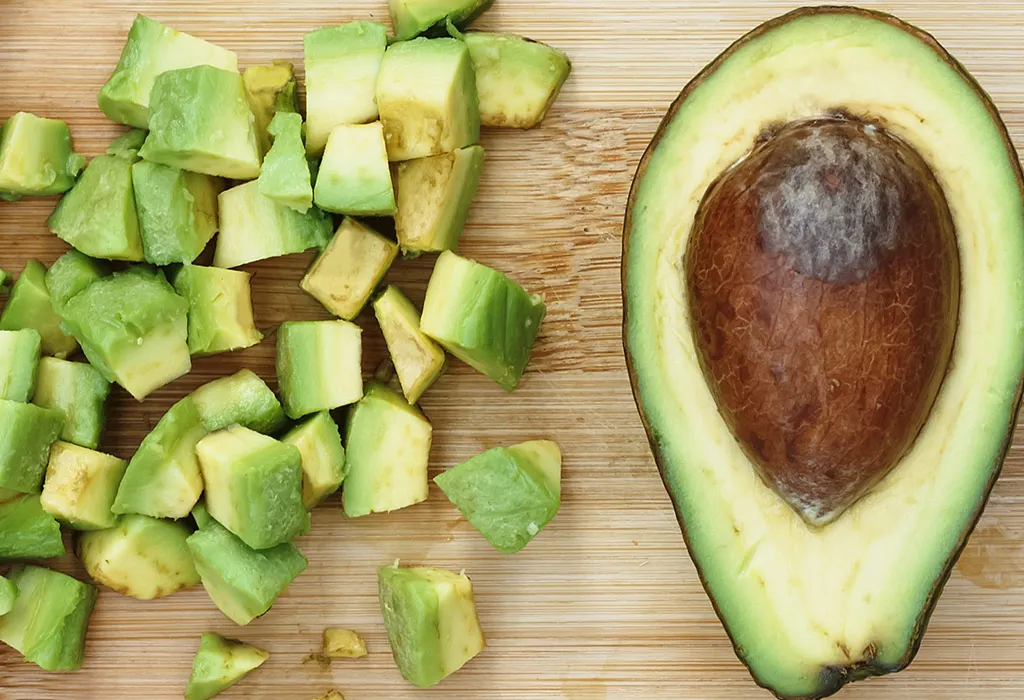
Quick and Short Avocado Recipes for Babies and Toddlers
Although avocados can be directly served to babies and young children, you can enhance their appeal to babies by trying different recipes. It is a very pliable medium and can be adapted to introduce different flavours and tastes to your child when mixed with other ingredients, especially if your baby isn’t too keen on the taste of avocado by itself.
Aromatic ingredients like garlic, cream cheese, pepper, basil, and other herbs gel well with avocado puree. Once your baby is a little older, you can use them to add some interesting flavours. Avocado can also be mixed with yoghurt and whole milk to adjust the consistency and introduce dairy into his diet in a subtle way.
Here are some quick and easy avocado recipes for infants.
1. Basic Mash
One of the simplest and most nutritious ways to serve avocado to children is as a mash. Start by cutting a ripe avocado in half and removing the pit with a knife. Then, scoop out the fleshy part with a spoon. Slice it thinly or cut it into cubes. With a fork, mash it thoroughly. This basic mash is a quick and easy way to serve avocado to your baby, ensuring they get all the goodness of this fruit.
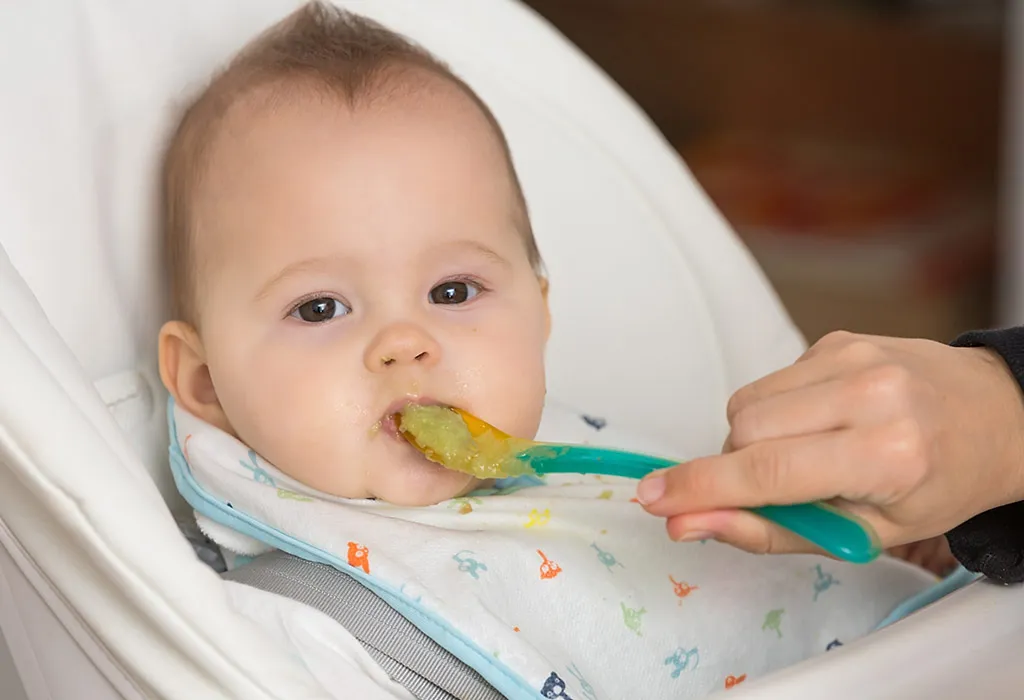
2. Avocado With Fruit
Diversify your baby’s diet by mashing avocado with other fruits like bananas. Dice each fruit separately, then blend it in a mixer until it is nice and creamy. For older babies, you can even mash it with a fork to retain texture and give them something to chew on.
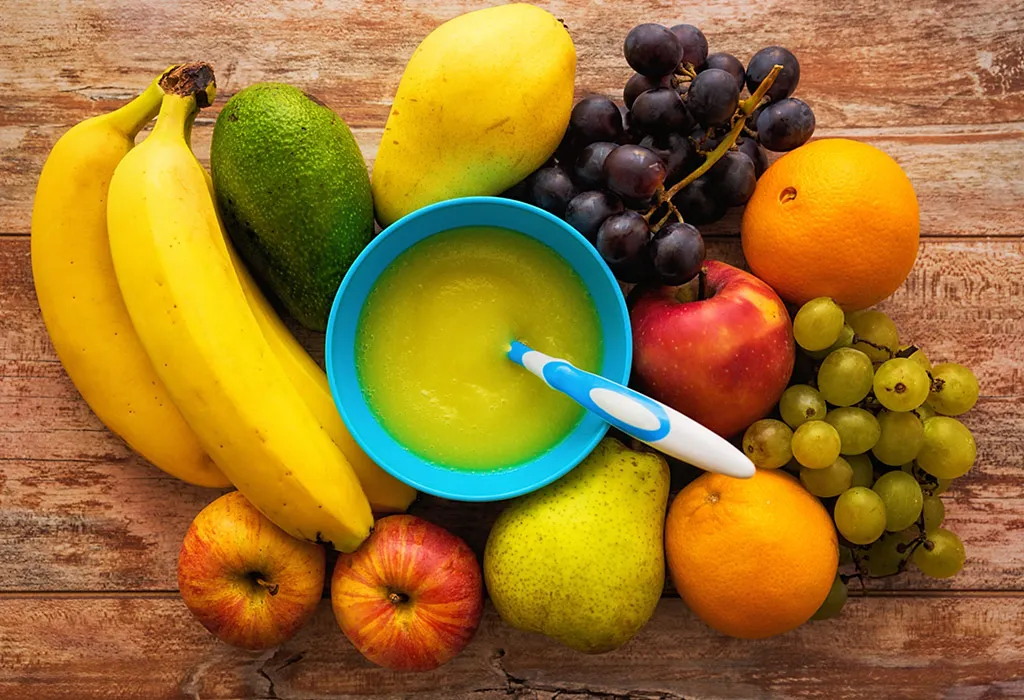
3. Savoury Avocado
The fruit works extremely well with savoury flavours and citrus fruit juices. Mix it with aromatic dried herbs like basil, pepper, mint, or garlic and add a dash of citrus juice from a lemon or orange to combine the flavours. Serve it to your baby or store it for later use. The addition of Vitamin C ensures the recipe is healthier. The dish can also be stored for a few days without discolouration. This dish is best for children over a year old.
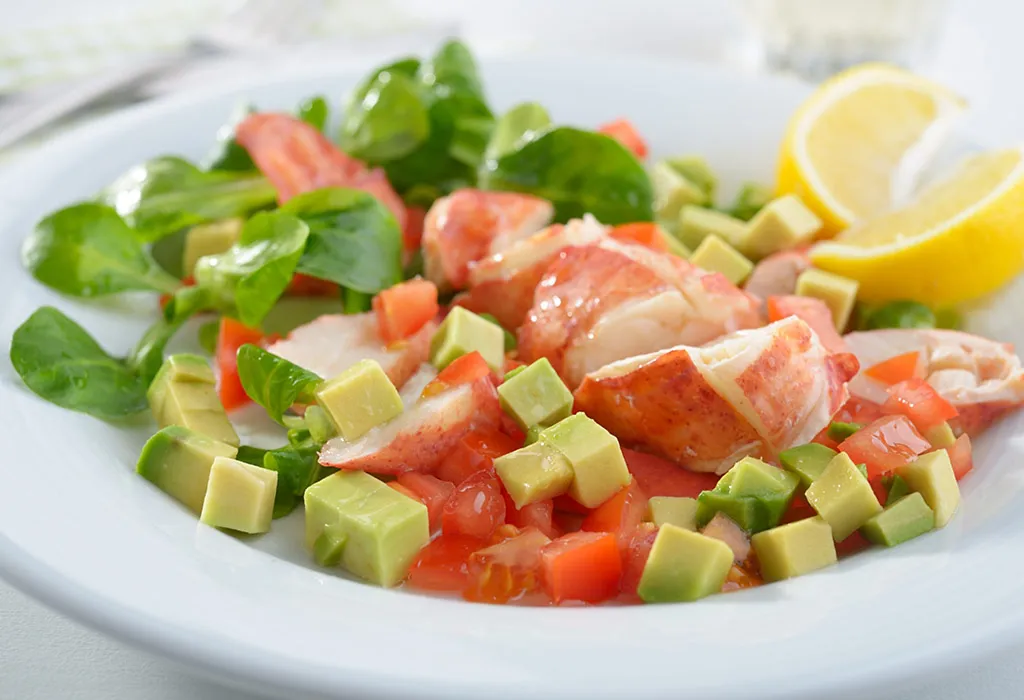
4. Creamy Avocado With Yoghurt
Like avocado, yoghurt is a superfood for babies, and you should try to include it in your child’s diet. One way to do this is to make a puree by mashing diced avocado into thick yoghurt. Young children will be well-accepted by the creamy texture and subtle flavours, and this easy-to-prepare recipe is always a great idea when you are in a hurry. This recipe is perfect for kids over seven months of age.
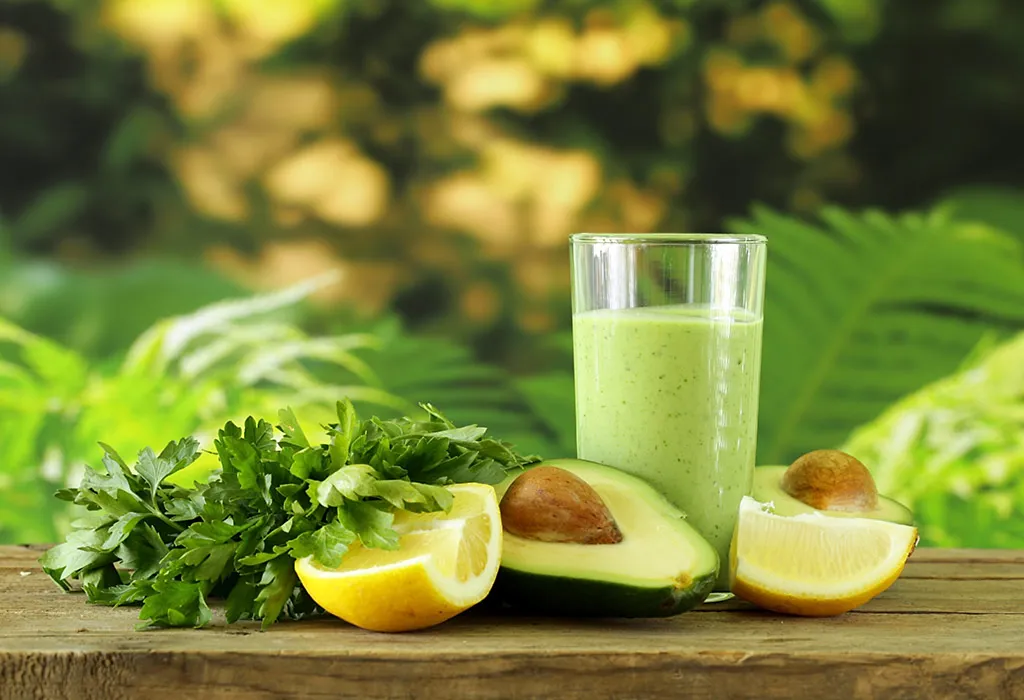
5. Avocado With Milk
Adding milk is the easiest way to soften an avocado and make it easy to consume. Simply mash the avocado and blend it with the required quantity of breast milk or cow’s milk to make a cereal-like or porridge-like dish that your child can easily consume with a spoon.
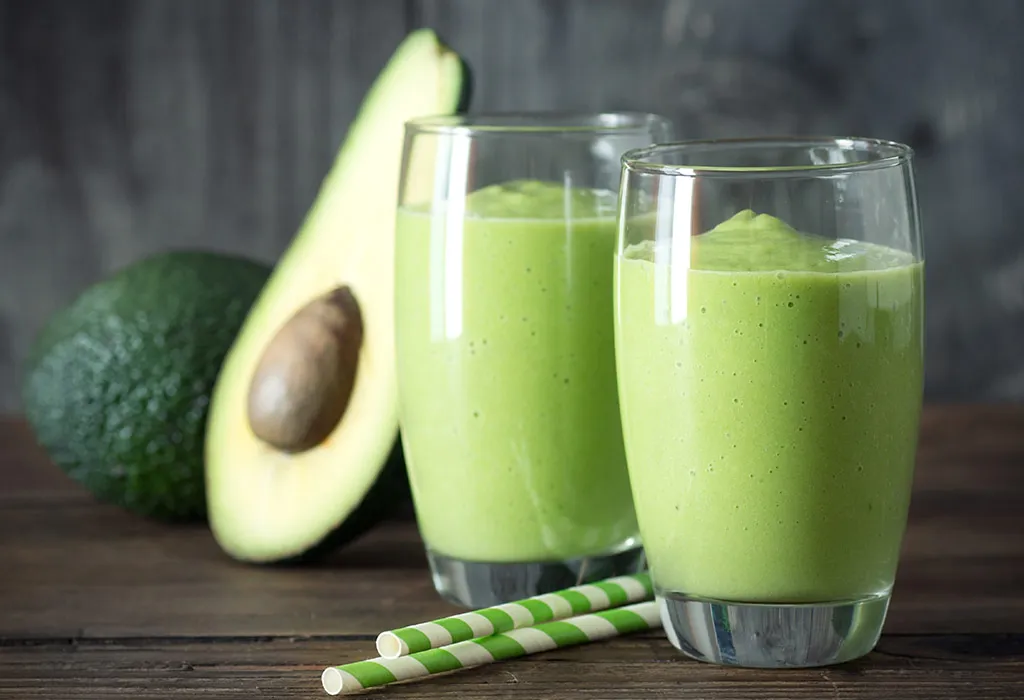
6. Avocado Fruit Salad
This simple but delicious avocado fruit salad recipe will entice your little one with a pop of colours and a burst of flavours. Mash avocado cubes with steamed pears and ripe bananas to a smooth consistency, or keep it at the desired texture with a few chunky bits to chew on. Blend some soft, creamy yoghurt into the mixture, and it will be the perfect dessert for your young one.
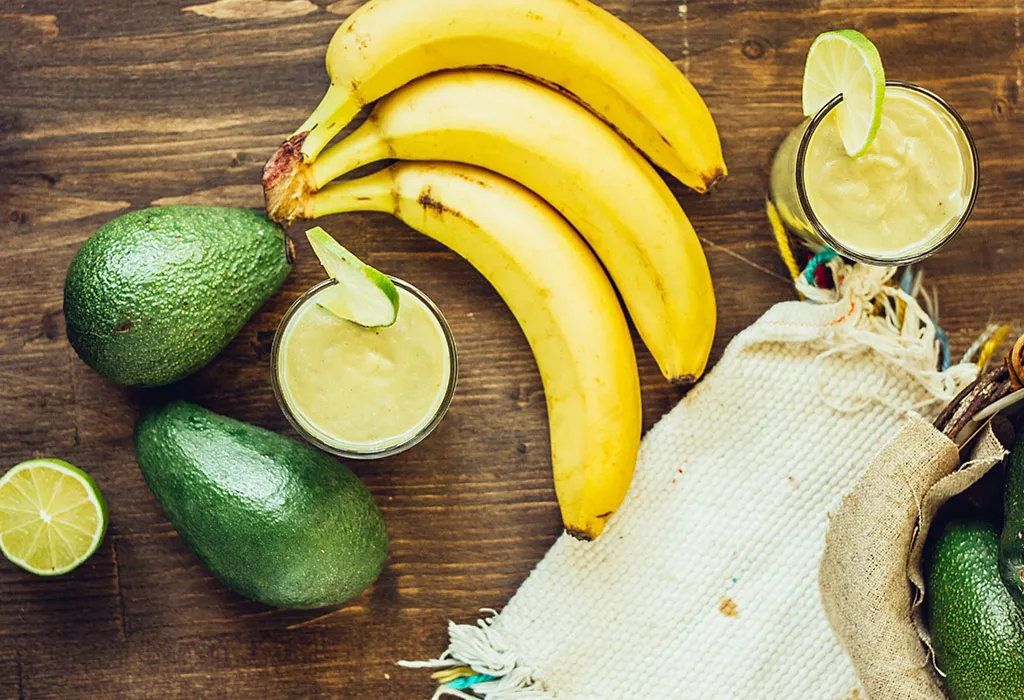
7. Guacamole
Avocado is synonymous with guacamole. Then, why shouldn’t your child enjoy his version of it when you are so fond of the dish? For your baby’s guacamole, mash up an avocado and flavour it with seasonings like garlic powder, crushed basil and wheat germ or cereal. If your child is over a year old, top it off with a dash of lime juice. Otherwise, mash the lot together, and it is ready to serve.
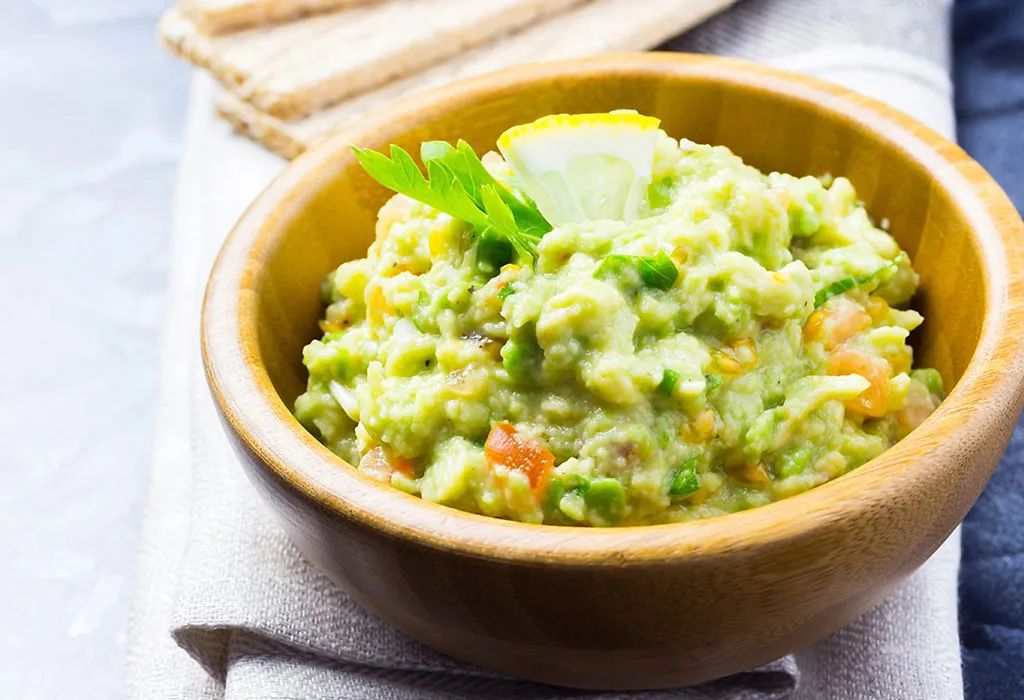
8. Avocado on Toast
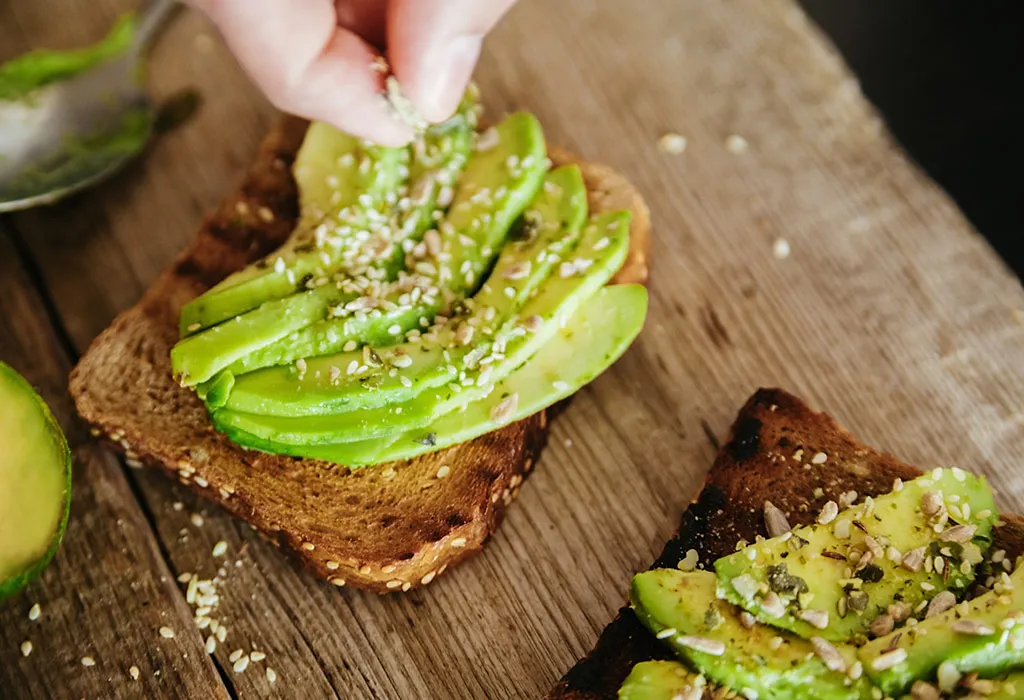
9. Avocado and Pasta
Mix mashed avocado with a few teaspoons of milk (or breast milk) to form a paste. Stir this mix into freshly cooked pasta and serve.
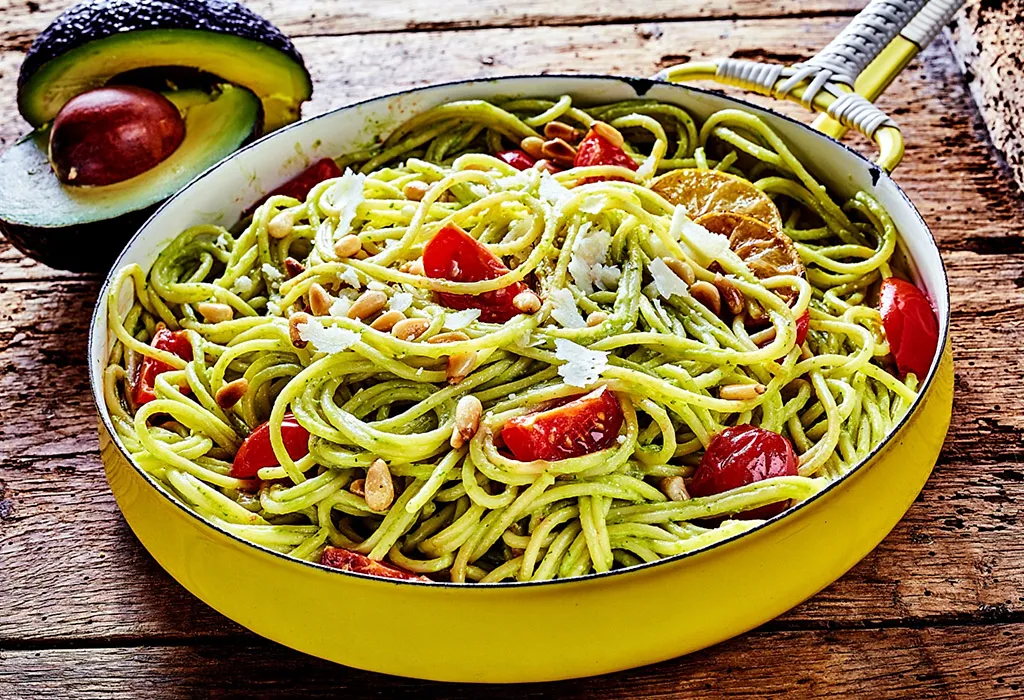
10. Avocado Chicken Mix
Blend well-cooked pieces of chicken with half an avocado till smooth. Serve it as such or spread it on toast for a quick and easy snack.
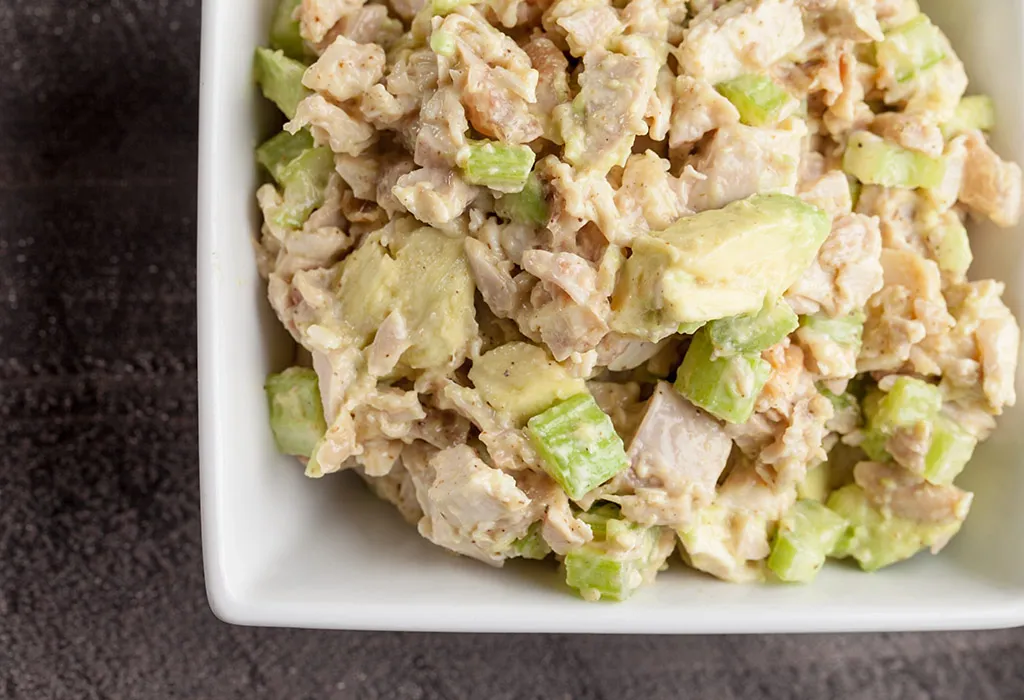
11. Mango and Avocado Puree
Mango and avocado puree for baby is a simple and nutritious option for introducing healthy fats and essential nutrients into their diet. You’ll need ripe mangoes and avocados to make this delicious puree for your baby. Start by peeling and removing the pit from the mangoes and avocados. Then, chop the fruits into small chunks and place them in a blender or food processor. Next, blend the mango and avocado until smooth and creamy. Add some water or breast milk to reach the desired consistency if the mixture is too thick.
FAQs
1. Can avocados cause allergies in babies?
Avocado is generally considered a low-allergy food and is rarely associated with allergic reactions in babies. However, as with any new food, it’s essential to monitor your baby closely for signs of allergic reactions, such as rash, hives, vomiting, or difficulty breathing. If you have a family history of avocado allergies or any concerns, consult your paediatrician before introducing it to your baby.
2. How much avocado should I give to my baby?
Take it slow and start with small amounts of avocado, such as a teaspoon or two. Gradually increase the portion size as your baby becomes accustomed to the taste and texture. Aim to incorporate avocado into your baby’s diet a few times a week alongside a variety of other fruits, vegetables, grains, and proteins to ensure a balanced diet.
3. Can I store leftover avocado puree for later use?
Yes, leftover avocado puree can be stored in an airtight container in the refrigerator for up to two days. To prevent browning, you can squeeze a little lemon or lime juice over the surface of the puree or cover it tightly with plastic wrap, ensuring that the wrap touches the surface of the puree to minimise air exposure.
The introduction of solids is an essential milestone for babies. Avocados, with their variety of health benefits, can become one delicious option during infancy to bring about healthy growth and development in your child. We hope this information was helpful. Although usually there is no harm in introducing this fruit to infants, if you want to, you may check with a paediatrician for a better way to feed this fruit to your little one. Begin slow and build his acceptance gradually, and your munchkin will reap the benefits of this fruit forever.
References/Resources:
1. Avocado raw; U.S. DEPARTMENT OF AGRICULTURE; https://fdc.nal.usda.gov/fdc-app.html#/food-details/1102652/nutrients; October 2020
2. Avocados; Harvard T.H. Chan – School of Public Health; https://www.hsph.harvard.edu/nutritionsource/avocados/
3. Comerford. K. B, Ayoob. K. T, Murray. R. D, Atkinson. S. A; The Role of Avocados in Complementary and Transitional Feeding; Nutrients; https://www.ncbi.nlm.nih.gov/pmc/articles/PMC4882728/; May 2016
4. Alkhalaf. M. I, Alansari. W. S, Ibrahim. E. A, ELhalwagy. M. E. A; Anti-oxidant, anti-inflammatory and anti-cancer activities of avocado (Persea americana) fruit and seed extract; Journal of King Saud University – Science; https://www.sciencedirect.com/science/article/pii/S1018364718315714; October 2019
5. The truth about fats: the good, the bad, and the in-between; Harvard Health Publishing; https://www.health.harvard.edu/staying-healthy/the-truth-about-fats-bad-and-good; April 2022
6. Kupnik. K, Primožič. M, Kokol. V, Knez. Ž, Leitgeb. M; Enzymatic, Antioxidant, and Antimicrobial Activities of Bioactive Compounds from Avocado (Persea americana L.) Seeds; Plants; https://www.ncbi.nlm.nih.gov/pmc/articles/PMC10007261/; March 2023
7. Bhuyan. D. J, Alsherbiny. M. A, Perera. S, Low. M, et al.; The Odyssey of Bioactive Compounds in Avocado (Persea americana) and Their Health Benefits; Antioxidants; https://www.ncbi.nlm.nih.gov/pmc/articles/PMC6826385/; September 2019
Also Read:
Chikko for Babies
Banana for Babies
Introducing Pineapple to Baby
Health Benefits of Watermelon for Babies
Was This Article Helpful?
Parenting is a huge responsibility, for you as a caregiver, but also for us as a parenting content platform. We understand that and take our responsibility of creating credible content seriously. FirstCry Parenting articles are written and published only after extensive research using factually sound references to deliver quality content that is accurate, validated by experts, and completely reliable. To understand how we go about creating content that is credible, read our editorial policy here.







